Ab-initio Study of the Diffusion Coefficients in Fe-based Liquids
- PDF / 1,015,448 Bytes
- 6 Pages / 612 x 792 pts (letter) Page_size
- 23 Downloads / 291 Views
MM3.8.1
Ab-initio Study of the Diffusion Coefficients in Fe-based Liquids Miguel Fuentes-Cabrera1,2, Don Nicholson1, Mike Widom2, Yang Wang3 and Marek Mihalkovic4 1
Oak Ridge National Laboratory, P.O. Box 2008, Oak Ridge, TN, 37831 2 Department of Physics, Carnegie Mellon University, PA 15213 3 Pittsburgh Supercomputing Center, Carnegie Mellon University, Pittsburgh, PA 15213, 4 Institute of Physics, Slovak Academy of Science, Bratislava, Slovakia ABSTRACT With atomistic force fields derived from ab-initio energies and atomic forces, we cooled Fe80B20 from the liquid to the glass state. The pair-distribution functions and the diffusion coefficients were used to characterize the structural changes that Fe80B20 underwent during the simulation. In the FeFe and FeB pair-distribution functions, when the temperature is lowered the first neighbor-peak becomes narrower and the secondneighbor peak splits at around 1000K. In the BB pair-distribution we observed that the first peak undergoes a significant change at the glass transition temperature, and that the first BB peak remains present at low temperatures. That the first BB peak exists at low temperature seems to contradict the prevailing view of the structure of transition metalmetalloid glasses. INTRODUCTION Despite the various and important applications that Bulk Metallic Glasses (BMG) could have, i.e. surgical blades, ships hulls, sporting goods, casing for consumers electronics, etc., there is not yet a clear understanding of the principles that guide their formation. Alloy designers use a set of empirical rules to select prospective BMG materials, but these rules fail often and the synthesis process is still inefficient. To solve this problem, we have designed a program directed toward understanding what guides glass formation. In this paper we demonstrate computational tools used to carry on systems-specific studies that can be directly compared to experiments. Fe80B20 does not form a bulk metallic glass but Poon et al. [1] has found that if Zr is added, the resulting Fe68Zr10B22 does form a bulk glass. They suggested that the glass forming ability of Fe68Zr10B22 is due to the presence of a ZrB backbone that enhances the stability of the undercooled melt. Our intention is to replicate Poon's experiment computationally. For this we have initiated the following plan: atomistic force fields will be developed to mimic ab-initio forces and energies in Fe80B20 and Fe68Zr10B22; both systems will be cooled from the liquid to the glass state and the glass transition temperature will be compared to experiments; during the simulations, the structural changes will be monitored to probe whether Fe68Zr10B22 contains a ZrB backbone. In this paper we present preliminary results for Fe80B20. METHODOLOGY AND RESULTS To carry on the simulations of Fe80B20, we followed a three-step process: i) ab-initio data
MM3.8.2
were obtained for Fe-B alloys, liquids and glasses with the Vienna Ab-initio Simulation Package (VASP) [2]; ii) the data were used to fit an atomistic force field of
Data Loading...











